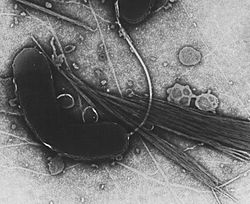Vibrio cholerae facts for kids
Quick facts for kids Vibrio cholerae |
|
|---|---|
 |
|
| Transmission electron microscope image | |
| Scientific classification | |
| Domain: | |
| Phylum: | |
| Class: |
Gamma Proteobacteria
|
| Order: |
Vibrionales
|
| Family: | |
| Genus: | |
| Binomial name | |
| Vibrio cholerae Pacini 1854
|
|
Vibrio cholerae is a tiny living thing called a bacterium. It is known for causing a sickness called cholera. This bacterium belongs to a group of similar tiny living things called Vibrio.
V. cholerae naturally lives in salty or slightly salty water. You can often find them attached to the shells of crabs, shrimps, and other shellfish. Some types of V. cholerae can make people sick with cholera. This usually happens if someone eats seafood that is raw or not cooked enough.
The sickness often spreads through unsafe food and water. This means it can spread very easily from person to person or place to place.
How to Stay Safe
If you are in an area where cholera is common, it's important to take some steps to stay healthy:
- Always drink and use water from sealed bottles.
- Wash your hands often with soap and clean water.
- If there's no toilet, use a chemical toilet or bury your waste far from water sources.
- Never go to the bathroom in any body of water, like a lake or river.
- Make sure all your food is cooked thoroughly before you eat it.
Having access to clean, safe water is very important. Keeping things clean, also known as sanitizing, helps a lot. Washing your hands is key, especially when soap and water are not available. If you can't use soap, you can scrub your hands with ash or sand and then rinse them with clean water. There is also a special shot, called a vaccine, that can help prevent cholera.
Images for kids
See also
 In Spanish: Vibrio cholerae para niños
In Spanish: Vibrio cholerae para niños




